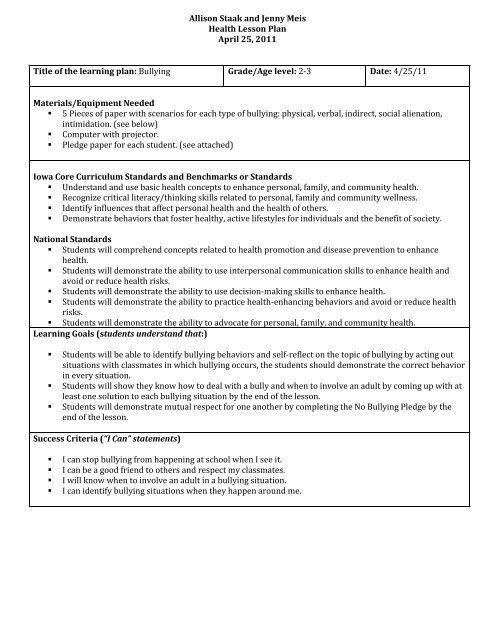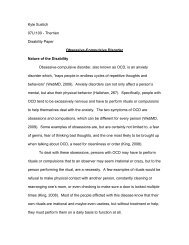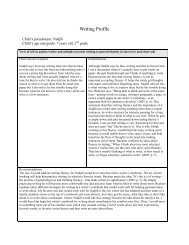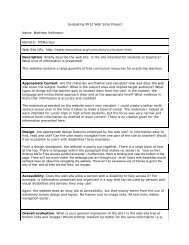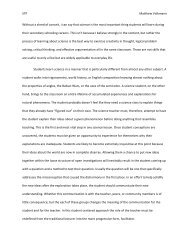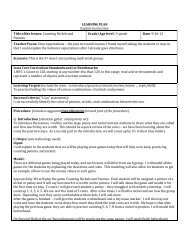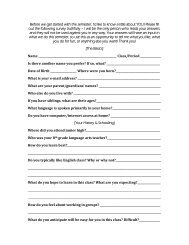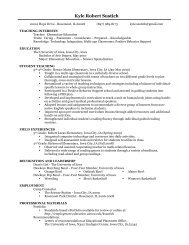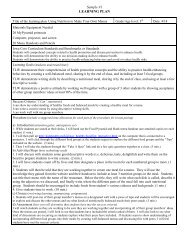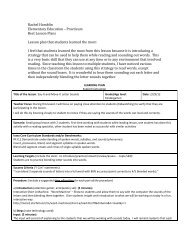Allison Staak and Jenny Meis Health Lesson Plan ... - Employment
Allison Staak and Jenny Meis Health Lesson Plan ... - Employment
Allison Staak and Jenny Meis Health Lesson Plan ... - Employment
You also want an ePaper? Increase the reach of your titles
YUMPU automatically turns print PDFs into web optimized ePapers that Google loves.
Title of the learning plan: Bullying<br />
<strong>Allison</strong> <strong>Staak</strong> <strong>and</strong> <strong>Jenny</strong> <strong>Meis</strong><br />
<strong>Health</strong> <strong>Lesson</strong> <strong>Plan</strong><br />
April 25, 2011<br />
Grade/Age level: 2-3 Date: 4/25/11<br />
Materials/Equipment Needed<br />
5 Pieces of paper with scenarios for each type of bullying: physical, verbal, indirect, social alienation,<br />
intimidation. (see below)<br />
Computer with projector.<br />
Pledge paper for each student. (see attached)<br />
Iowa Core Curriculum St<strong>and</strong>ards <strong>and</strong> Benchmarks or St<strong>and</strong>ards<br />
Underst<strong>and</strong> <strong>and</strong> use basic health concepts to enhance personal, family, <strong>and</strong> community health.<br />
Recognize critical literacy/thinking skills related to personal, family <strong>and</strong> community wellness.<br />
Identify influences that affect personal health <strong>and</strong> the health of others.<br />
Demonstrate behaviors that foster healthy, active lifestyles for individuals <strong>and</strong> the benefit of society.<br />
National St<strong>and</strong>ards<br />
Students will comprehend concepts related to health promotion <strong>and</strong> disease prevention to enhance<br />
health.<br />
Students will demonstrate the ability to use interpersonal communication skills to enhance health <strong>and</strong><br />
avoid or reduce health risks.<br />
Students will demonstrate the ability to use decision-making skills to enhance health.<br />
Students will demonstrate the ability to practice health-enhancing behaviors <strong>and</strong> avoid or reduce health<br />
risks.<br />
Students will demonstrate the ability to advocate for personal, family, <strong>and</strong> community health.<br />
Learning Goals (students underst<strong>and</strong> that:)<br />
Students will be able to identify bullying behaviors <strong>and</strong> self-reflect on the topic of bullying by acting out<br />
situations with classmates in which bullying occurs, the students should demonstrate the correct behavior<br />
in every situation.<br />
Students will show they know how to deal with a bully <strong>and</strong> when to involve an adult by coming up with at<br />
least one solution to each bullying situation by the end of the lesson.<br />
Students will demonstrate mutual respect for one another by completing the No Bullying Pledge by the<br />
end of the lesson.<br />
Success Criteria (“I Can” statements)<br />
I can stop bullying from happening at school when I see it.<br />
I can be a good friend to others <strong>and</strong> respect my classmates.<br />
I will know when to involve an adult in a bullying situation.<br />
I can identify bullying situations when they happen around me.
Procedure (include a suggested time allocation for each part of the procedure for lesson pacing)<br />
a) Introduction (attention getter, anticipatory set)<br />
1. The students will be introduced to bullying by watching “Stop the Bully”, a video by McGruff the crime dog.<br />
(computer <strong>and</strong> projector needed)<br />
http://www.mcgruff.org/stories/-- Bullying movie<br />
2. After the short clip there are 3 choices on how to resolve the situation. Have the students put their heads down<br />
<strong>and</strong> vote on a choice. Once everyone has voted, click on the choice that was most popular to play. If they chose the<br />
wrong answer, direct them to correct choice <strong>and</strong> play.—(3 minutes)<br />
b) Activities/Steps (note technology used)<br />
1. Explain to the class what bullying is <strong>and</strong> what a bully does. Bullies usually threaten or hurt other kids when no<br />
adults are around to see them do it. They know that if an adult did see them, the adult would stop the bully <strong>and</strong><br />
help the victim. Instead, bullies wait until recess, between classes, or the walk home to push other kids around.<br />
They usually do it where other kids can see them, though. Bullies like an audience. It helps them feel powerful.—<br />
(1 minute)<br />
2. Have the students number off 1 through 5 to put them into 5 groups to represent the 5 different kinds of<br />
bullying.<br />
3. Give each a group of piece of paper, which will include the type of bullying <strong>and</strong> 2 options to choose from to act<br />
out in front of the class. Explain to students <strong>and</strong> make sure they underst<strong>and</strong> that:<br />
Give the students 2 minutes to come up with their scenario.<br />
Their act should be less that 1 minute.<br />
The students will only act out the problem; they will stop acting at the conflict.<br />
Once group has completed their scene they will sit down <strong>and</strong> the whole class will discuss possible<br />
solutions to the bullying. —(3 minutes)<br />
Remind students that the ways they can stop bullying are to:<br />
1. Speak up. Tell the bully what you think of what’s going on. By saying, “that’s not funny, let’s get out of<br />
here” or something similar, you can help st<strong>and</strong> up for another kid.<br />
2. Be a friend. When kids go somewhere without their friends, they are more likely to get picked on by a<br />
bully. If you see someone being picked on, even if you don’t know the person, be a friend <strong>and</strong> ask the kid to<br />
walk away from the bully with you.<br />
3. Get an adult. If you see someone being bullied, get an adult. Either tell the adult what is going on or ask<br />
the adult to talk to the kid who is being bullied.<br />
Types of bullying are:<br />
1. Physical bullying includes any physical contact that would hurt or injure a person like hitting, kicking,<br />
punching, etc. Taking something that belongs to someone else <strong>and</strong> destroying it would also be considered a<br />
type of physical bullying.<br />
2. Verbal bullying is name-calling, making offensive remarks, or joking about a person's religion, gender,<br />
ethnicity, socioeconomic status, or the way they look.<br />
3. Indirect bullying includes spreading rumors or stories about someone, telling others about something<br />
that was told to you in private, <strong>and</strong> excluding others from groups.<br />
4. Social alienation is when a bully excludes someone from a group on purpose. It also includes a bully<br />
spreading rumors, <strong>and</strong> also making fun of someone by pointing out their differences.<br />
5. Intimidation is when a bully threatens someone else <strong>and</strong> frightens that person enough to make him or<br />
her do what the bully wants.<br />
4. Before the groups begin to act, they will say their type of bullying <strong>and</strong> what it is. Then the group will act out<br />
their scene (problem only) followed by a brief class discussion about possible solutions.—(10 minutes)<br />
c) Closure (reviewing learning, summarizing, assignments)<br />
1. Tell students that, most kids don’t like watching another kid get bullied. When one kid sees another being
ullied, he or she can feel scared <strong>and</strong> powerless. That doesn’t have to be. When you see someone being bullied,<br />
remember what we talked about today.<br />
2. Project the following (which teacher will have available on computer). Tell the students to read over the list<br />
quietly to themselves, <strong>and</strong> tell them that if they have done any of these things they have been a bully.—(1 minute)<br />
Have you ever...?<br />
Called someone a name?<br />
Physically hurt someone (punched, kicked, hit, etc.) on purpose?<br />
Used your size to hurt or scare other kids?<br />
Made fun of or criticized others who are different than you?<br />
Taken someone else's belongings without their permission?<br />
Said mean comments about someone behind their back?<br />
Spread rumors or gossiped about someone?<br />
Whispered secrets to a friend in front of another person <strong>and</strong> did not share the secret with that<br />
person just to hurt their feelings?<br />
Excluded someone from your group of friends on purpose?<br />
Been part of a clique that will not let other kids join their group?<br />
Been bullied yourself <strong>and</strong> therefore felt that you had the right to bully others?<br />
Tried to make someone cry?<br />
Enjoyed making someone feel sad, scared, or left out because of what you said or did to them?<br />
3. Tell students that if you found that you have been a bully then it is OK—it is not too late!<br />
4. H<strong>and</strong> out a pledge form to each student (see attached).<br />
5. Students will create a pledge with the help of the teacher. The teacher will write the finished pledge on the<br />
board. (The pledge should be 2-3 sentences long).<br />
6. Now every student will copy the pledge. The students will sign the pledges. Students will also draw a picture<br />
about<br />
what is means to be a good friend in the box provided. The pledges will be displayed around the classroom.—(7<br />
minutes)<br />
d) Assessment (how you will determine that students have met the success criteria)<br />
The students will be assessed according to their participation during the acting portion of the lesson. Their pledge<br />
will serve as a proof of contribution <strong>and</strong> success within the lesson.
Evidence of addressing diversity (for example: cultural, gender, linguistic, religious, sexual identify, socioeconomic,<br />
etc.)<br />
Groups will be picked in a r<strong>and</strong>om manner. The video at the beginning of the lesson includes multiracial<br />
individuals.<br />
Differentiation for cognitive, affective, psycho-motor needs<br />
Cognitive: Students with cognitive needs will be given the assignment in advance, knowing what to expect. They<br />
will also be placed in a group that will be sure to support his/her needs.<br />
Affective: Students with affective needs will be given an important role within their group to engage them in the<br />
activity. In addition, this student will be placed in a group where no distractions are present.<br />
Psychomotor: Students with psychomotor needs will have the same access to the project as all other students. If<br />
needed, there will be additional help given to this students.<br />
Teacher Reflection/Focus (ways you’ll determine the success of the learning experience for learners <strong>and</strong> for<br />
you; changes you would make another time; subsequent shifts in your thinking)<br />
1. Physical bullying includes any physical contact that would hurt or injure a person like hitting, kicking,<br />
punching, etc. Taking something that belongs to someone else <strong>and</strong> destroying it would also be considered<br />
a type of physical bullying.<br />
a. At least once a week, Tommy waits for Juan after school <strong>and</strong> physically hurts him. Juan has<br />
never figured out why Tommy has a problem with him <strong>and</strong> always hurts him. Juan feels that he<br />
cannot go to any teacher because Tommy is a good student <strong>and</strong> all of the teachers love him.<br />
b. Allie is getting pushed around <strong>and</strong> teased a lot at recess. She dresses kind of different <strong>and</strong><br />
acts weird sometimes. When kids tease her, she gets real mad. She’s too scared to do anything,<br />
but she doesn’t deserve this. She has no friends <strong>and</strong> seems really sad.<br />
2. Verbal bullying is name-calling, making offensive remarks, or joking about a person's religion, gender,<br />
ethnicity, socioeconomic status, or the way they look.<br />
a. In the halls between classes, Cristina accidentally bumps into Maria. Maria gets angry <strong>and</strong><br />
calls Cristina fat. Everybody in the hall hears <strong>and</strong> starts to laugh. Cristina feels too ashamed to<br />
tell her parents that everyone in school is making fun of her.<br />
b. It’s time for the yearly head lice check. Shaine got sent home yesterday because the nurse<br />
found lice in his hair. The next day Shaine comes to school <strong>and</strong> everyone calls him lice head,<br />
dirtball, <strong>and</strong> showerless Shaine when he tries to talk to them.<br />
3. Indirect bullying includes spreading rumors or stories about someone, telling others about something<br />
that was told to you in private, <strong>and</strong> excluding others from groups.<br />
a. Before school in the hallway a group of girls are laughing <strong>and</strong> talking to each other. They<br />
look like they are having fun. It took a lot of courage for Emily to walk over <strong>and</strong> join their group.<br />
As soon as she does, the group of girls stops talking to each other <strong>and</strong> look at each other like she<br />
is crazy. Emily doesn’t know what to do so she walks away trying not to cry.<br />
b. Halen tells Max <strong>and</strong> Tyler he really likes a girl in their class named Alexis. Max <strong>and</strong> Tyler<br />
think it would be funny if they write a love letter from Halen <strong>and</strong> put it in Alexis’ desk without<br />
telling Halen they are doing it. When Alexis finds it she laughs <strong>and</strong> tells Halen he’s ugly. Not only<br />
did this hurt Halen’s feelings, but Halen get really embarrassed <strong>and</strong> runs out of the room.<br />
4. Social alienation is when a bully excludes someone from a group on purpose. It also includes a bully<br />
spreading rumors, <strong>and</strong> also making fun of someone by pointing out their differences.<br />
a. A group of students are sitting at a lunch <strong>and</strong> whispering back <strong>and</strong> forth to each other<br />
looking at the student getting bullied <strong>and</strong> laughing. This hurts the student’s feelings <strong>and</strong> he/she<br />
doesn’t know what to do.
. Eric, the class bully starts a rumor about Jessica <strong>and</strong> tells the whole class that she kissed<br />
Tony at recess. No one will talk to her because Tony smells bad. No one will let her sit with them<br />
at lunch.<br />
5. Intimidation is when a bully threatens someone else <strong>and</strong> frightens that person enough to make him or her<br />
do what the bully wants.<br />
a. Jashanna did not study for the big test today. She knows her best friend Kendra did so she<br />
plans on sitting next to her to copy her answers. When Kendra tells Jashanna that she does not<br />
want to help her cheat, Jashanna threatens to stop being Kendra’s friend. Though Kendra does<br />
not want to, she helps Jashanna cheat.<br />
b. Jordan steals Jose’s lunch money at recess <strong>and</strong> tells him if he tells anyone he will beat him<br />
up at the big football game that night. Now Jose doesn’t have any lunch money <strong>and</strong> won’t be able<br />
to eat lunch today. Jose starts yelling at Jordan to give his lunch money back <strong>and</strong> the teacher<br />
walks over to them asking what the problem is.


